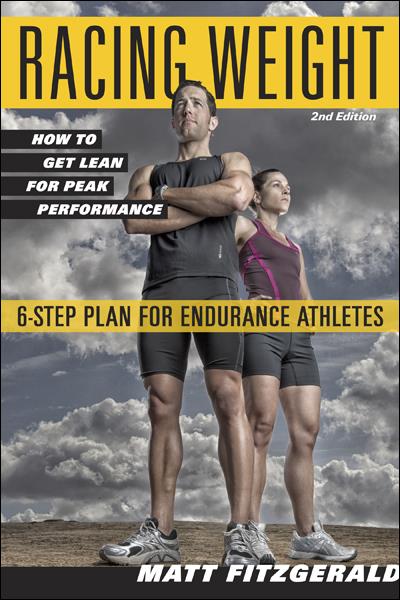Everfit Book Review - Racing Weight
Book Reviews, June 14, 2015
Review of Racing Weight - how to get lean for peak performance by Matt Fitzgerald.
In 2011 a swiss study (Knechtle et al. 2011) looking at 186 age group IM athletes found that both body weight and body fat % were more strongly correlated with split times and total race times than training variables such as weekly training hours. I know with the limited time I have for training I want to get the most value out of it. Getting more towards my optimum training weight is helping with performance goals. One of the most crucial underpinnings of endurance performance is the ability to deliver oxygen to muscles. Body fat is a metabolically active organ that competes with working muscles for blood supply. A certain amount of body fat is required for good health, but any more is just dead weight.
In another study (Hecht et al. 2007) researchers found that the average body fat % among age group athletes in an IM triathlon was 17% for males and 27% for females – these values are lower than the general population but much higher than the pros (Pro males 6-10%, females 12-16%). Sure enough when they were matched against finishing times the men and women with the leanest bodies were also the fastest. Body fat makes only a tiny positive contribution to endurance performance by providing energy – but fat is never the limiting factor in any race, carbohydrates are. Therefore one of the natural adaptations that the body makes to endurance training is loss of body fat.
This book consisted of 6 steps to put in place to help you reach you racing weight. Your ideal racing weight (optimum performance weight) is an individualised measure that is an ongoing challenge to work towards. Getting the balance between your weight, body fat %, and performance requires constant analysis and as Chris McCormack puts it “is one of the many jigsaw pieces of endurance training”. The book was not about following a marketed “diet” or “eating cult” like Paleo, blood type or the 40/40/20 ratio diet. It was more about looking at making eating for health and performance part of your lifestyle much the same as the training is.
Rule 1 – Improving your diet quality
Increasing your nutrition-per-calorie ratio of your diet will help you to get all the nutrients you require for performance from lower kcal consumed enabling you to get lean. Basically eat more fruit, vegetables, lean meat, fish, and high quality low processed carbs e.g. brown rice, wholegrain bread and quinoa.
Rule 2 – Manage your appetite
Our modern food environment is set up with highly processed poor nutrition food. We overeat without even realising it. We need to plan out weekly shops, so we have the right food at home, and then prepare the food we are going to eat during the day (prepare your lunch and snacks for work) so take always/vending machines isn’t the fall back when “poor planning” hunger strikes us. We have to start learning the difference between “head” hunger and “belly” hunger.
Rule 3 – Balance your energy sources
The fact that none of the marketable “diets” out there can agree on the “magical” proportions of carbs, fats, and proteins tend to suggest there isn’t one. The proportions of the macronutrients will need to change depending on what you are trying to achieve, what training you have on, and what time of the day it is. We are all individuals and trying to rely on general dietary advice is not smart.
Rule 4- Monitor yourself
The most common weight management practise for people who have lost weight and kept it off are self management practises such as regular weighing and food journaling. For athlete’s success in enhanced with monitoring diet, body composition, weight, and matching that with performance. A 2007 study published in the journal Clinical Nutrition that compared measurements obtained form a Tanita (bioelectrical impedance) body-fat scale and DEXA scanning (expensive) reported a better than 96 % level of agreement between the two methods (Thomson et al. 2007). Everfit Coaching has a pair of these scales if athletes want to start a monitoring plan.
Rule 5- Timing your nutrition
When you eat affects your body as much as what you eat. Timing of your food intake has a big impact on ENERGY PARTITIONING – this is what becomes of your kcal you consume. Basically there are three destinations of food in your body, muscle, fat cells, and energy. If you want to become leaner you need to shift the balance of energy partitioning so more kcal are incorporated into muscle, less stored as fat, and more used to supply immediate energy concerns. Basically the shift we all want athlete or otherwise is making this shift so there is less “poor health” associated fat tissue, and more metabolism-boosting muscle tissue. Practising nutrient timing will help you achieve your optimum performance weight.
Rule 6- Train Right!
Exercise is the most powerful factor in successful weight management. More than 90% of people who succeed in losing weight and keeping it off exercise regularly. For most athletes weight management is not the primary goal. Usually getting better performance is (among other reasons). Performance enhancement and weight management go hand in hand. The best results come from a programme where roughly 80% of training is EASY, 10% is STEADY/MODHARD, and 10% is HARD (or over your anaerobic threshold). Strength training in the form of functional body weight exercises also improves body composition and performance.

.jpg?version=8)